Inverness: Difference between revisions
TrevorHunt (talk | contribs) Inverness Church of Scotland churches (Presbytery Clerk) |
|||
| Line 65: | Line 65: | ||
*[[Church of Scotland]]: | *[[Church of Scotland]]: | ||
** The Old High Church [http://www.churchesinverness.com/Old-High-Church-g.asp] | ** The Old High Church [http://www.churchesinverness.com/Old-High-Church-g.asp] | ||
** | ** St Stephen's Church [http://oldhighststephens.com/] | ||
**Crown Church | **Crown Church | ||
**Dalneigh & Bona Church | |||
**East Church | |||
**Hilton Parish Church | **Hilton Parish Church | ||
** Inshes Church | ** Inshes Church | ||
** Inverness Trinity Parish Church | ** Inverness Trinity Parish Church | ||
**St Columba | ** Kinmylies Church | ||
**Ness Bank | **St Columba New Charge | ||
**Ness Bank Church | |||
* City Life Church | * City Life Church | ||
* Free Presbyterian Church of Scotland: Auldcastle Road | * Free Presbyterian Church of Scotland: Auldcastle Road | ||
Latest revision as of 19:27, 24 September 2018
| Inverness Gaelic: Inbhir Nis | |
| Inverness-shire | |
|---|---|
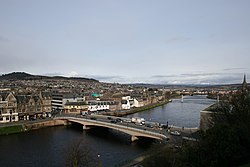 Aerial view of Inverness | |
| Location | |
| Grid reference: | NH666450 |
| Location: | 57°28’18"N, 4°13’31"W |
| Data | |
| Population: | 56,660 (2008 est.) |
| Post town: | Inverness |
| Postcode: | IV1-IV3, IV5, IV13, IV63 |
| Dialling code: | 01463 |
| Local Government | |
| Council: | Highland Council |
| Parliamentary constituency: |
Inverness, Nairn, Badenoch and Strathspey |
Inverness is the county town of Inverness-shire and the northernmost city in the United Kingdom. It is considered to be the Capital of the Highlands.
The city stands at the north-eastern extremity of the Great Glen, where the River Ness enters the Moray Firth, its name coming from the Gaelic Inbhir Nis meaning mouth of the Ness). Its position makes it a meeting place of trade routes by sea and by land. A settlement was established by the 6th century and the first royal charter being granted by King David I in the 12th century.
The town
Inverness stands at the mouth of the River Ness, which flows out from nearby Loch Ness. The Ness empties into the Inverness Firth, the south-western extremity of the Moray Firth. On the Firth are the city's harbour and port facilities.
The city centre lies on the east bank of the river and is linked to the west side of the town by three road bridges (Ness Bridge, Friars Bridge and the Black (or Waterloo) Bridge) and by one of the town's suspension foot bridges, the Grieg Street Bridge.[1]
As befits its place as the regional capital, Inverness has a full range of shops inside the town and in out-of-town-centres supplying villages across the Highlands and up to Caithness.
The traditional city centre was a triangle bounded by High Street, Church Street and Academy Street, within which Union Street and Queensgate are cross streets parallel to High Street. Between Union Street and Queensgate is the Victorian Market, which contains a large number of small shops.[2] The main Inverness railway station is almost directly opposite the Academy Street entrance to the Market.
From the 1970s, the Eastgate Shopping Centre was developed to the east of High Street, with a substantial extension being completed in 2003.
The population of Inverness increased by over 10% from 1991–2001 and from 1997-2007[3] with an estimated population in 2008 of 56,660.[4] Inverness is now the fastest growing city in Scotland, already home to a quarter of the population of all the Highlands.[5] It is ranked fifth out of 189 British cities for its quality of life, the highest of any Scottish city.[6]
The Great Glen Fault on top of which the city is built, is seismically active. However the last earthquake to affect Inverness in 1934.[7]
City status
In 2001 The Queen granted city status to the Town of Inverness, and letters patent were taken into the possession of the Highland Council by the convener of the Inverness area committee. These letters patent, which were sealed in March 2001 and are held by Inverness Museum and Art Gallery create a city of Inverness, but do not refer to any defined boundaries.
In January 2008 a petition to matriculate armorial bearings for the City of Inverness was refused by Lord Lyon King of Arms on the grounds that there is no legal persona to which arms can be granted.[8]
Around the town
The Ness in the town centre is a modest river. Its origin is Loch Ness, 6 miles southwest of the Ness Bridge.
The Ness Islands, a publicly owned park, consist of two wooded islands connected by footbridges and has been used as a place of recreation since the 1840s.[9] Craig Phadraig, once an ancient Pictish or Gaelic hillfort is a 790-foot hill which offers hikes on a clear pathway through the wooded terrain.[10]
The city is a centre for Highland holidays
The city lies near the site of the Battle of Culloden of 1746.[11]
The Great Glen
Inverness stands at the north-eastern end of the Great Glen or "Glen More" which stretches in a straight line from the Atlantic coast to the North Sea. The Glen marks the Great Glen Fault, which reaches as far as Lough Foyle, between the counties of Londonderry and Donegal.
The Great Glen contains:
- The River Ness and at its head Loch Ness, the longest and deepest loch in Britain, with Loch Ashie and Loch Duntelchaig further south-west;
- Loch Oich, and Loch Lochy at the south-western end; and
- The Caledonian Canal joining the two sets of lochs and thus providing a boat passage from the Atlantic to the North Sea.
Churches
Inverness has been a core area of the Free Churches, some of the congregations sundered from the Church of Scotland at the Great Disruption, some rejoining the Kirk later. Many churches are found in the city:
- Church of Scotland:
- City Life Church
- Free Presbyterian Church of Scotland: Auldcastle Road
- Free Church of Scotland:
- Free North Church
- Greyfriars
- Methodist: Inverness Methodist Church
- New Day International: Inverness Community Church
- Reformed Baptist Church
- Scottish Episcopal Church:
- St Andrew's Cathedral
- St Michael and All Angels
- Roman Catholic: St Mary's
Economy
Most of the traditional industries such as distilling have been replaced by high-tech businesses, such as the design and manufacture of diabetes diagnostic kits. Highlands and Islands Enterprise has partly funded the Centre for Health Science with a view to attracting more businesses in the medical and medical devices business to the area.
Inverness is home to Scottish Natural Heritage following that body's relocation from Edinburgh. SNH provides a large number of jobs in the area.
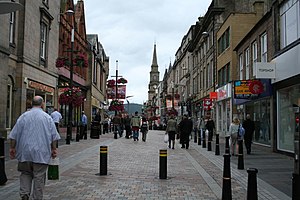
Buildings
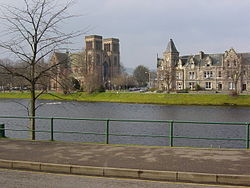
Important buildings in Inverness include Inverness Castle, Inverness College and its many churches.
'Inverness Castle was built in 1835 on the site of its mediæval predecessor. It is now a sheriff court.
Inverness Cathedral is a cathedral of the Scottish Episcopal Church and is the seat of the ordinary of the Diocese of Moray, Ross and Caithness. It is dedicated to St Andrew. The cathedral has a curiously square-topped look to its spires, as funds ran out before they could be completed.
The oldest church is the Old High Church (Church of Scotland) on St Michael's Mount by the riverside, a site perhaps used for worship since Celtic times. The church tower dates from mediæval times, making it the oldest surviving building in Inverness. It is used by the Church of Scotland congregation of Old High St Stephen's and it is the venue for the annual Kirking of the Council, which is attended by local councillors.
Inverness College is now the hub campus for the UHI Millennium Institute.[12]
Porterfield Prison, officially HMP Inverness, serves the courts of the Highlands, Western Isles, Orkney Isles and Moray, providing secure custody for all remand prisoners and short term adult prisoners, both male and female (segregated).[13]
Culture
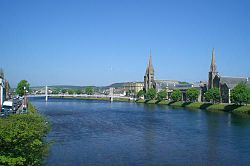
Inverness is an important centre for bagpipe players and lovers, since every September the city hosts the Northern Meeting, the most prestigious solo piping competition in the world. The Inverness cape, a garment worn in the rain by pipers the world over, is not necessarily made in Inverness.
Another major event in calendar is the annual City of Inverness Highland Games. In 2006 Inverness hosted Scotland's biggest ever Highland Games over two days in July, featuring the Masters' World Championships, the showcase event for heavies aged over 40 years. 2006 was the first year that the Masters' World Championships had been held outside the United States, and it attracted many top heavies from around the world to the Inverness area.
Inverness is home to two summer music festivals, Rockness and the Tartan Heart Festival, that bring a variety of different music to the town.
Inverness is the location of Macbeth's castle in Shakespeare's play.
Gaelic language
Gaelic appears on some signs around Inverness as a significant number of people speaking the language in the city. Inverness indeed is a centre of the "Scottish Gaelic Renaissance".
The Inverness Gaelic primary school Bun-sgoil Ghàidhlig Inbhir Nis, which opened in August 2007, offers primary school education through the medium of Gaelic, is nearing full capacity and has had to be extended to allow for more pupils come August 2010.[14]
The Bòrd na Gàidhlig, the Gaelic Language Board, has its main office in Inverness, wherefrom it carries out its task of supporting and promoting the use of Gaelic.[15]
Sport
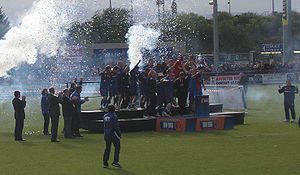
Football
- Inverness Caledonian Thistle FC, formed in 1994 "Calley Thistle"
- Clachnacuddin FC, plays in the Highland League
- Inverness City FC formed in 2006, play in the North Region Juniors.
Rugby Union
- Highland RFC competes in the Scottish Hydro Electric National Leagues division two.
Cricket
Highland CC and Northern Counties playing in Inverness, in the North of Scotland Cricket Association League. Seven welfare league teams playing midweek cricket at Fraser Park. Both teams have been very successful over the years. Highland joined the league in 1957 and won its first league title in 2002 and recaptured the title in 2007.
Others
Bught Park, located in the centre of Inverness is the finishing point of the annual Loch Ness Marathon and home of Inverness Shinty Club.
In 2007, the city hosted Highland 2007, a celebration of the culture of the Highlands, and will also host the World Highland Games Heavy Championships (21 & 22 July) and European Pipe Band Championships (28 July).[16] 2008 saw the first Hi-Ex (Highlands International Comics Expo), held at the Eden Court Theatre.[17][18]
History
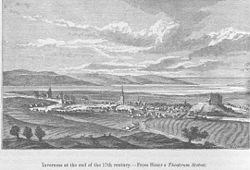
Inverness was one of the chief strongholds of the Picts, and in AD 565 was visited by St Columba with the intention of converting the Pictish king Bridei or Brude, who is supposed to have resided in the vitrified fort on Craig Phadrig,[19] on the western edge of the city. A 93 oz silver chain dating to 500-800 was found just to the south at Torvean in 1983.[20] A church or a monk's cell is thought to have been established by early Celtic monks on St Michael's Mount, a mound close to the river, now the site of the Old High Church[21] and graveyard. The castle is said to have been built by Malcolm III of Scotland, after he had razed to the ground the castle in which Macbeth had, according to much later tradition, murdered Malcolm's father Duncan I, and which stood on a hill half a mile to the north-east.
The strategic location of Inverness has led to many conflicts in the area. Reputedly there was a battle in the early 11th century between King Malcolm and Thorfinn of Norway at Blar Nam Feinne, to the southwest of the city.[22]
Inverness had four traditional fairs, one of them being[Legavrik (leth-gheamradh). William the Lion (d. 1214) granted Inverness four charters, by one of which it was created a royal burgh. Of the Dominican friary founded by Alexander III in 1233, only one pillar and a worn knight's effigy survive in a secluded graveyard near the town centre.
Mediæval Inverness suffered regular raids from the Outer Hebrides, particularly by the MacDonald Lords of the Isles in the fifteenth century. In 1187 one Donald Bane led islanders in a battle at Torvean against men from Inverness Castle led by the governor's son, Duncan Mackintosh.[23] Both leaders were killed in the battle, Donald Bane is said to have been buried in a large cairn near the river, close to where the silver chain was found.[24] Local tradition says that the citizens fought off the Clan MacDonald in 1340 at the Battle of Blairnacoi on Drumderfit Hill, north of Inverness across the Beauly Firth.[25] On his way to the Battle of Harlaw in 1411, Donald of Islay harried the city, and sixteen years later James I held a parliament in the castle to which the northern chieftains were summoned, of whom three were executed for asserting an independent sovereignty. Clan Munro defeated Clan Mackintosh in 1454 at the Battle of Clachnaharry just west of the city.[26] The Clan MacDonald and their allies stormed the castle during the Raid on Ross in 1491.
In 1562, during the progress undertaken to suppress Huntly's insurrection, Mary, Queen of Scots, was denied admittance into Inverness Castle by the governor, who belonged to the earl's faction, and whom she afterwards caused to be hanged. The Clan Munro and Clan Fraser took the castle for her.[27] The house in which she lived meanwhile stood in Bridge Street until the 1970s, when it was demolished to make way for the second Bridge Street development. The city's Marymass Fair, on the Saturday nearest 15 August, (a tradition revived in 1986) is said to commemorate Queen Mary as well as the Mary, the Virgin Mary.
Beyond the then northern limits of the town, Oliver Cromwell built a citadel capable of accommodating 1,000 men, but with the exception of a portion of the ramparts it was demolished at the Restoration. The only surviving modern remnant is a clock tower. In 1715 the Jacobites occupied the royal fortress as a barracks. In 1727 the government built the first Fort George here, but in 1746 it surrendered to the Jacobites and they blew it up.[28]
Culloden Moor lies nearby, and was the site of the Battle of Culloden in 1746, which ended the Jacobite Rising of 1745-1746.
On September 7, 1921, the first British Cabinet meeting to be held outside London took place in the Town House, when David Lloyd George, on holiday in Gairloch, called an emergency meeting to discuss the situation in Ireland. The Inverness Formula composed at this meeting was the basis of the Anglo-Irish Treaty.
Place names
Inverness and its immediate hinterland have a rich Gaelic place-names.[29]
| Placename | Original Gaelic | Meaning |
|---|---|---|
| Inverness | Inbhir Nis | Mouth of the River Ness |
| Ben Wyvis | Beinn Uais | Mountain Terror |
| Scorguie | Sgurr Gaoithe | The Windy Hill |
| Clachnaharry | Clach na h-Aithrigh | Stone of Repentance |
| Balloch | Am Bealach | The Pass |
| Resaurie | Ruigh Samhraidh | Summer Slope |
| Raigmore | Rathaig Mhòir | Big Fort |
| Balnafettack | Baile nam Feadag | Farm of the Plovers |
| Culloden | Cùil Lodair | Nook of the Marsh |
| Dalneigh | Dail an Eich | Field of the Horse |
| Culduthel | Cuil Daothail | Quite northern spot |
| Culcabock | Cùil na Càbaig | Back of the Tillage Land |
| Dalmagarry | Dail Mac Gearraidh | Garry's Son's Haugh |
| Tomatin | Tom Aitinn | Hill of the Juniper |
| Dell | Dail MhicEachainn | MacEachen's Haugh |
| Diriebught | Tìr nam Bochd | Land of the Poor |
| Dochfour | Dabhach Phùir | Davoch of Pasture Land |
| Placename | Original Gaelic | Meaning |
|---|---|---|
| Dochgarroch | Dabhach Gairbheach | Davoch of Rough Place |
| Dores | Dubhras | Black Wood |
| Drummond | An Druimein | The Ridge |
| Drumossie | Druim Athaisidh | Ridge of Great Haugh |
| Castle Heather | Caisteal Leathoir | Castle on the Slope |
| Inshes | Na h-Innseagan | The Meadows |
| Kessock | Ceasaig | (Saint) Ceasaig |
| Kimmylies | Ceann a' Mhìlidh | The Warrior's Head |
| Leachkin | Leacainn | Broad Hillside |
| Merkinch | Marc Innis | The Horse Meadow |
| Millburn | Allt a' Mhuilinn | The Mill River |
| Slackbuie | An Slag Buidhe | The Yellow Hollow |
| Smithton | Baile a' Ghobhainn | Smiths' Town |
| Tomnahurich | Tom na h-Iubhraich | Hill of the Yew / Faeries |
| Torvean | Tòrr Bheathain | MacBean's Hill |
| Abertarff | Obar Thairbh | Mouth of the Bull River |
| Ballifeary | Baile na Faire | The Guard's Farm |
References
- ↑ "Inverness Town Centre Map". Stockphotography.co.uk. http://www.stockphotography.co.uk/UK/Maps/Inverness.asp. Retrieved 2010-07-14.
- ↑ "Inverness Shops". Explore-inverness.com. 2010-03-15. http://www.explore-inverness.com/shops.htm. Retrieved 2010-07-14.
- ↑ The Scottish Government Publications Economic Report 2004. Retrieved 28 March 2009.
- ↑ "GRO Scotland Mid-2008 Population Estimates - Settlements in order of size". GRO Scotland. http://www.gro-scotland.gov.uk/files2/stats/population-estimates/08mye-settlements-table2.xls. Retrieved 2010-08-12.
- ↑ "Overview of Inverness". Scottish-places.info. http://www.scottish-places.info/towns/townfirst2064.html. Retrieved 2010-07-14.
- ↑ "''Property market: Is your home recession proof?'' Telegraph.co.uk 12:01am GMT 03/02/2008, accessed 6 March 2008". Telegraph.co.uk. 2008-02-07. http://www.telegraph.co.uk/property/main.jhtml?xml=/property/2008/02/03/precession103.xml&page=2. Retrieved 2010-07-14.
- ↑ http://www.invernessroyal.highland.sch.uk/resources/earthquakes.html
- ↑ "''Coat of arms rejected in city status query'', The Inverness Courier, accessed February 12, 2008". Inverness-courier.co.uk. 2008-01-29. http://www.inverness-courier.co.uk/news/fullstory.php/aid/5000/Coat_of_arms_rejected_in_city_status_query.html. Retrieved 2010-07-14.
- ↑ http://www.nessriver.co.uk/pages/nessriver/nessIslands.html
- ↑ http://walking.visitscotland.com/perfect-walks/dunainhill-craigphadraig/ Craig Phadraig - Walking
- ↑ "Inverness city". Inverness-scotland.com. http://www.inverness-scotland.com/in-and-around-2-inverness.asp. Retrieved 2010-07-14.
- ↑ "UHI Millennium Institute website". Uhi.ac.uk. http://www.uhi.ac.uk/. Retrieved 2010-07-14.
- ↑ HMP Inverness, Scottish Prison Service
- ↑ "Gaelic Primary School education set to expand in Inverness area (12/11/09) - Comann Nam Pàrant - Inbhir Nis". Cnp-inbhirnis.com. 2009-11-12. http://www.cnp-inbhirnis.com/1/post/2009/11/gaelic-primary-school-education-set-to-expand-in-inverness-area-121109.html. Retrieved 2010-07-14.
- ↑ Bòrd na Gàidhlig
- ↑ "''Highland 2007'', Information on the European Pipe Band Championships". Highland2007.com. http://www.highland2007.com/default.aspx.locid-07lnew05l.Lang-EN.htm. Retrieved 2010-07-14.
- ↑ First superheroes expo for north, BBC, January 18, 2008
- ↑ Scots' impact on comics examined, BBC, January 18, 2008
- ↑ "''Craig Phadrig, Inverness'', Walk in Scotland, Visitscotland". Walking.visitscotland.com. 2008-03-27. http://walking.visitscotland.com/walks/nescotland/213042. Retrieved 2010-07-14.
- ↑ "Site Record for Torvaine, Caledonian Canal, Inverness; Torvean". Royal Commission on the Ancient and Historical Monuments of Scotland. http://canmore.rcahms.gov.uk/en/site/13495/. Silver chain was found at NH65424346 when digging the Caledonian Canal in 1809.
- ↑ "Inverness churches". Churchesinverness.com. http://www.churchesinverness.com/Old-High-Church-g.asp. Retrieved 2010-07-14.
- ↑ "Site Record for Blar Nam Feinne". Royal Commission on the Ancient and Historical Monuments of Scotland. http://canmore.rcahms.gov.uk/en/site/12728/. Blar Nam Feinne is on Cnoc na Moine (NH595433).
- ↑ Site Record for Torvaine, Torbane, Royal Commission on the Ancient and Historical Monuments of Scotland, http://canmore.rcahms.gov.uk/en/site/13540/. RCAHMS locate the battle of Torvean at NH65414346
- ↑ "Site Record for Torvaine". Royal Commission on the Ancient and Historical Monuments of Scotland. http://canmore.rcahms.gov.uk/en/site/13538/. The cairn at NH65424346 disappeared in the 19th or 20th centuries, it has also been claimed to mark the resting place of St Bean (Beóán) the Culdee.
- ↑ "Site Record for Battle Of Blairnacoi, Drumderfit Hill". Royal Commission on the Ancient and Historical Monuments of Scotland. http://canmore.rcahms.gov.uk/en/site/13574/ NH656521
- ↑ "Site Record for Clachnaharry, Clan Battle Monument, Clachnaharry Memorial". Royal Commission on the Ancient and Historical Monuments of Scotland. http://canmore.rcahms.gov.uk/en/site/13458/. Battle of Clachnaharry took place at NH6454946448.
- ↑ George Buchanan's (1506 -1582), History of Scotland, completed in 1579, first published in 1582.
- ↑ "Inverness on Undiscovered Scotland". Undiscoveredscotland.co.uk. http://www.undiscoveredscotland.co.uk/inverness/inverness/. Retrieved 2010-07-14.
- ↑ "A'Chleit (Argyll), A' Chleit" (PDF). http://www.polfest.org/vli/language/gaelic/pdfs/placenamesA-B.pdf. Retrieved 2010-07-14.
Outside links
- Inverness Castle
- Inverness Information
- Inverness Music Listings
- Inverness Riverside Churches
- Inverness Highland Year of Culture
- A map of Inverness from 1716
| Cities in the United Kingdom |
|---|
|
Aberdeen • Armagh • Bangor (Caernarfonshire) • Bangor (County Down) • Bath • Belfast • Birmingham • Bradford • Brighton and Hove • Bristol • Cambridge • Canterbury • Cardiff • Carlisle • Chelmsford • Chester • Chichester • Colchester • Coventry • Derby • Doncaster • Dundee • Dunfermline • Durham • Ely • Edinburgh • Exeter • Glasgow • Gloucester • Hereford • Inverness • Kingston upon Hull • Lancaster • Leeds • Leicester • Lichfield • Lincoln • Lisburn • Liverpool • City of London • Londonderry • Manchester • Milton Keynes • Newcastle upon Tyne • Newport • Newry • Norwich • Nottingham • Oxford • Perth • Peterborough • Plymouth • Portsmouth • Preston • Ripon • Rochester • Salford • Salisbury • Sheffield • Southampton • St Albans • St Asaph • St David's • Southend-on-Sea • Stirling • Stoke-on-Trent • Sunderland • Swansea • Truro • Wakefield • Wells • Westminster • Winchester • Wolverhampton • Worcester • Wrexham • York |